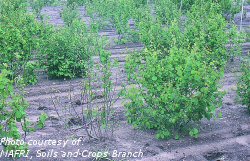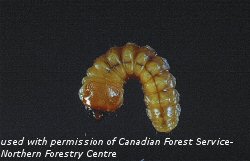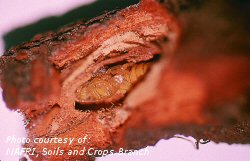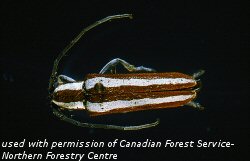Round-Headed Apple Tree Borer (Saperda Candida)

Apple tree borer damage to saskatoon

Saperda candida larva

Saperda candida pupa in root of saskatoon

Saperda candida adult beetle
Host Plants And Distribution
Saskatoon, apple, hawthorn and mountain ash. This insect is primarily an eastern species. In Canada, it has been reported in both Manitoba and Saskatchewan. It may be found in North Dakota, Minnesota and east from these areas. A subspecies known as the saskatoon borer, Saperda bipunctata is found everywhere the apple tree borer is found and is known to occur widely in Saskatchewan.
Biology
The life cycle takes three years to complete. Adults are light brown beetles with two white stripes extending along the length of the body on the back. The body is 20 mm long and the antennae are at least as long. Adults are present in June and July, during which time they mate and females deposit eggs in slits at the base of saskatoon stems. The larvae are whitish or yellowish, legless grubs that feed beneath the outer bark of the stem. Feeding on the inner bark and sapwood carries on for two to three years, during which the larvae make large tunnels in the stem. Pupation occurs within the tunnels and the adults emerge in June. Populations are not synchronized so adults are produced each year.
Symptoms And Damage
Feeding damage may girdle the stems and cause die-back. Visually, the damage is very similar to that observed with the woolly elm aphid. Damage from this insect can be distinguished by cracking and splits in the bark of the lower stem, which is not associated with the woolly elm aphid. Initially, the larvae are small, so damage may not be visible until the second or third year of the insect’s development. Plants within rows may be mostly healthy with only occasionally affected plants. Newer plantings are likely more susceptible than established stands.
Scouting Techniques
Visual inspection is the only method currently available. Scouting may be done for adult beetles during June and July. Inspection of the plants for cracked or split stems may indicate presence of larvae.
Economic Thresholds
Economic thresholds have not been established for this insect. In most cases involving saskatoon, larvae will eventually kill the plant. Removal and destruction of infested material is the only control method currently available.

